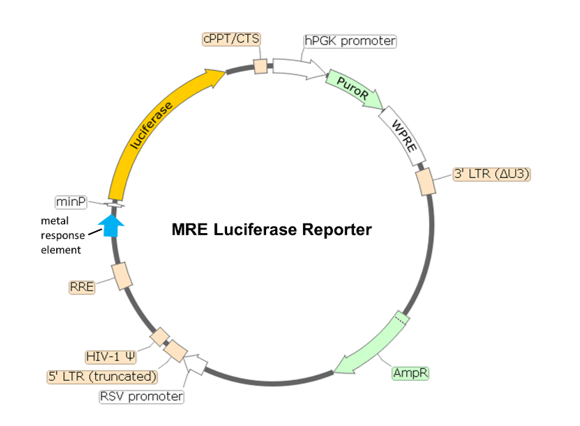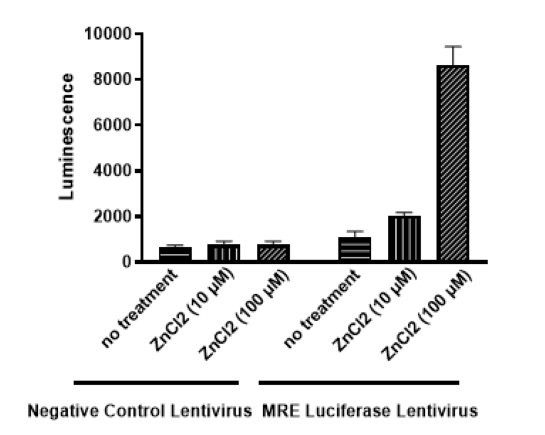MRE Luciferase Reporter Lentivirus (Heavy Metal Stress)
MRE Luciferase Reporter Lentiviruses (Heavy Metal Stress) are replication incompetent, HIV-based, VSV-G pseudotyped lentiviral particles that are ready to transduce nearly all types of mammalian cells, including primary and non-dividing cells. These viruses contain a firefly luciferase reporter driven by multiple copies of MRE (metal response elements) located upstream of the minimal TATA promoter, and a puromycin selection marker (Figure 1).
After transduction, transcription mediated by MRE can be monitored by measuring luciferase activity.

Figure 1. Schematic of the lenti-vector used to generate the MRE Luciferase Reporter Lentivirus (Heavy Metal Stress).
| Name | Ordering Information |
| HepG2 Cells | ATCC #HB-8065 |
| Thaw Medium 1 | BPS Bioscience #60187 |
| Assay Medium 1 | BPS Bioscience #78674 |
| ZnCl2 | Sigma #Z0152 |
| 96-well tissue culture, clear-bottom, white plate | Corning #3610 |
| One-Step™ Luciferase Assay System | BPS Bioscience #60690 |
| Luminometer |
The lentivirus particles were produced from HEK293T cells. They are supplied in cell culture medium containing 90% DMEM + 10% FBS. Virus particles can be packaged in custom formulations by special request, for an additional fee.
Metal ions are important structural components of many enzymes and cofactors of enzymatic reactions. Essential metals include zinc, copper and iron. Zinc is a common co-factor of hydrolytic enzymes and a structural factor in proteins like zinc finger proteins, known to bind to more than 300 enzymes and 2000 transcription factors. It participates in responses to oxidative stress, DNA replication and repair, cell cycle, apoptosis and aging. It is crucial for the proper development of the brain, and tight control of its levels in the central neural system is essential. In vertebrates, zinc homeostasis is kept via the zinc-dependent regulation of the transcription of metallothioneins (MTs), scavengers of heavy metals that protect against oxidative stress, by the interaction of MTF-1 (MRE-binding transcription factor 1) with MREs (metal response element). MRE is the cis-acting DNA element that can be found in promoters of zing-regulated genes, and that binds MTF-1 and other zinc-related transcription factors. Dysregulation of metal levels in the organism can lead to pathologies such as Alzheimer’s disease, with excess zinc linking to hyperphosphorylated tau aggregation. An understanding of the pathways and partners involved in metal stress regulation will bring benefits to patients suffering from zinc-related diseases.
Giedroc D., et al., 2001 Antioxidants &Redox Signaling 3(4): 577-596.
Li Z., et al., 2023 Biomolecules 13(1):28.


